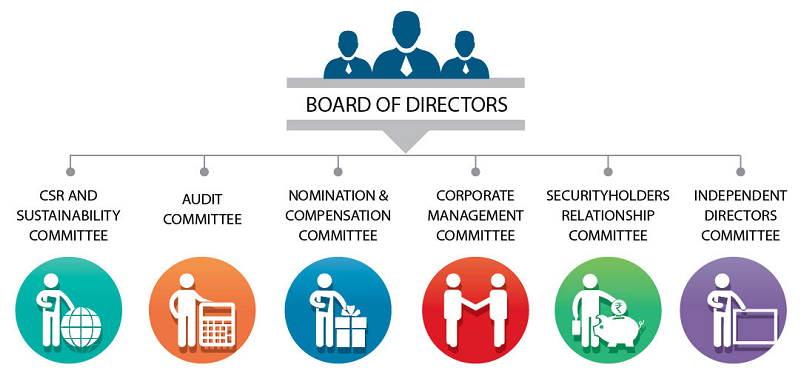
C-Corporations, due to their size and complexity, require a robust framework to ensure smooth and ethical operations. A pivotal element of this framework is ‘Corporate Governance’ — the system of rules, practices, and processes that direct and control a corporation. Within this system, committees play a vital role. They provide a mechanism for bringing together diverse viewpoints, fostering in-depth discussion, and facilitating effective decision-making on various key issues. Here we explain what these committees are, why they’re necessary, the various types of committees within a C-Corporation, and how they enhance corporate governance.
Contents
Understanding C-Corporation Structure
Before we examine the role of committees in a C-Corporation’s governance, it’s crucial to comprehend the structure of a C-Corporation. This foundational knowledge will offer us insights into where these committees fit in and how they contribute to the overall functioning of the corporation.
Defining a C-Corporation
A C-Corporation, often referred to as a ‘C-Corp,’ is a legal entity distinct from its owners (shareholders), offering them limited liability protection. This means the corporation’s debts and obligations are separate from the personal liabilities of the shareholders. One of the distinguishing features of a C-Corporation is its ability to raise capital through the issuance of various classes of stock to an unlimited number of shareholders.
Explaining the Hierarchy of a C-Corporation
The hierarchy of a C-Corporation comprises three main levels. At the top, you have the shareholders who are the owners of the corporation. Shareholders have the power to elect the board of directors, who are charged with the responsibility of overseeing the corporation’s activities.
The board of directors sits at the second level of the hierarchy. They set the strategic direction of the corporation and make significant decisions such as mergers and acquisitions, financial planning, and executive compensation. They also appoint the corporate officers, such as the CEO, CFO, and COO, who manage the daily operations of the corporation.
At the base level, you have the corporate officers and other employees who carry out the corporation’s daily operations based on the strategy and policies established by the board of directors.
The Relationship between Corporate Structure and Corporate Governance
Corporate structure and corporate governance are inextricably linked. The corporate structure, as described above, is the formal setup of roles and responsibilities within the corporation, while corporate governance is the system that guides how these roles interact and make decisions.
The board of directors plays a critical role in this governance structure, ensuring the corporation acts in the best interests of its shareholders. However, given the wide array of issues that a board needs to oversee, it’s nearly impossible for the full board to adequately delve into all of these matters. This is where committees come in. They allow for a more focused approach to governance, enhancing efficiency and effectiveness in decision-making [1].

The Concept of Committees in a C-Corporation
Now that we’ve covered the fundamentals of a C-Corporation’s structure, we can shift our focus to the role of committees in these corporations. These groups perform key functions, contribute to efficiency and transparency, and aid in the facilitation of corporate governance.
Definition of a Committee in a C-Corporation
Within a C-Corporation, a committee is a subset of the board of directors. It is formed by delegating certain responsibilities and tasks to a smaller group of directors. This structure allows for more focused discussions and efficient decision-making on specific matters. Each committee operates under a charter that outlines its roles, responsibilities, and the rules for its operation.
Reasons for Establishing Committees
Committees are formed for several reasons. Firstly, they allow the board of directors to divide and conquer, handling complex issues that need detailed attention and specialized knowledge. This setup helps in streamlining discussions and decision-making processes. Secondly, committees enable corporations to comply with legal and regulatory requirements. Certain jurisdictions or stock exchanges necessitate the formation of specific committees. Lastly, committees can promote transparency and accountability, building trust among stakeholders and shareholders.
The Legal Requirements for Committees in a C-Corporation
While there are no universal legal requirements for all committees in a C-Corporation, certain types of committees may be mandated by law or by the rules of the stock exchange where a corporation’s shares are listed. For instance, public companies listed on the New York Stock Exchange (NYSE) or NASDAQ are required to have at least an Audit Committee and a Compensation Committee. The specific legal requirements depend on various factors including the corporation’s size, industry, and the jurisdiction in which it operates [2].

Different Types of Committees in a C-Corporation
Committees within a C-Corporation vary depending on the company’s specific needs, regulatory requirements, and governance practices. However, there are several types of committees that are quite common across many C-Corporations. Each of these committees focuses on a different aspect of corporate governance, aiding the board in overseeing the various elements of the corporation’s operations.
Audit Committee
The first committee we will examine is the Audit Committee, one of the most fundamental committees in a corporation.
Role and Responsibilities
The Audit Committee is primarily responsible for overseeing the corporation’s financial reporting processes, ensuring accuracy, transparency, and compliance with legal and regulatory standards. Key responsibilities of the Audit Committee include selecting the external auditor, reviewing the auditor’s findings, monitoring the company’s internal control systems, and addressing issues related to the company’s accounting policies and practices.
Importance in Governance
The importance of the Audit Committee in governance cannot be overstated. It plays a crucial role in ensuring financial integrity and transparency. By doing so, it helps maintain investor confidence, attract potential investors, and meet regulatory requirements [3].
Compensation Committee
Next, we’ll discuss the Compensation Committee, another key component of corporate governance.
Role and Responsibilities
The Compensation Committee is tasked with overseeing the company’s compensation policies, particularly for the corporation’s top executives. This includes determining salaries, bonuses, stock options, and other forms of compensation for the executive team. They also review and approve performance goals for executive compensation.
Importance in Governance
The Compensation Committee’s work is crucial for aligning the interests of executives with those of shareholders. The structure and amounts of executive compensation can incentivize executives to pursue strategies that increase shareholder value. Moreover, by ensuring that compensation is fair and tied to performance, the committee helps to maintain employee motivation and morale, and shareholder trust.
Nominating/Corporate Governance Committee
Lastly, we have the Nominating or Corporate Governance Committee.
Role and Responsibilities
This committee is responsible for identifying, evaluating, and recommending candidates for the corporation’s board of directors. It also develops and recommends to the board a set of corporate governance principles and oversees the evaluation of the board and its committees.
Importance in Governance
The Nominating/Corporate Governance Committee plays a key role in shaping the composition of the board, which ultimately determines the direction and success of the corporation. By ensuring the board consists of individuals with the necessary skills, experience, and diversity, this committee contributes to effective governance and the long-term success of the corporation [4].
Other Potential Committees and Their Roles
Besides the above-mentioned committees, C-Corporations may have other committees depending on their specific needs and governance philosophy. These can include Risk Management Committee, Compliance Committee, Technology Committee, or Sustainability Committee, among others. Each of these committees focuses on a specific area, contributing to more robust and comprehensive corporate governance.

How Committees Enhance Corporate Governance
Committees play a critical role in strengthening the governance of a C-Corporation. By focusing on specific areas, they augment the board of directors’ ability to effectively oversee a corporation’s operations and strategy.
Increased Accountability and Oversight
Committees foster a system of checks and balances within a corporation. They provide a focused oversight mechanism that helps prevent mismanagement, fraud, and unethical practices. For instance, an Audit Committee ensures the integrity of a company’s financial reports, while a Compensation Committee helps prevent excessive or unwarranted executive compensation.
Specialization and Expertise
Given their concentrated areas of focus, committees allow for greater specialization and expertise. They often consist of members who have specific knowledge and experience relevant to the committee’s function. This specialized knowledge is particularly beneficial when dealing with complex issues that require in-depth understanding. For example, members of a Technology Committee might have a background in IT, allowing them to better understand and oversee the corporation’s technological initiatives.
Improved Decision-Making Processes
Committees can enhance decision-making processes within a corporation. They allow for more detailed discussions and exploration of issues, which leads to well-informed decisions. Also, by dealing with specific issues at the committee level, the board can focus on broader strategic matters, thereby increasing the efficiency of board meetings.
Enhanced Transparency and Confidence
Committees promote transparency in a corporation’s operations, contributing to improved relationships with shareholders and stakeholders. When committees function effectively, they communicate their activities and decisions, providing stakeholders with a clear picture of the corporation’s operations and governance practices. This transparency can lead to increased investor confidence and improved corporate reputation.
Challenges and Limitations of Committees in C-Corporation Governance
While committees play a critical role in C-Corporation governance, they are not without potential challenges and limitations. Recognizing these is important for managing their impact and maximizing the effectiveness of committees.
Potential for Power Concentration
One potential challenge is the risk of power concentration within a small group of directors. When a handful of individuals make decisions on crucial matters, there’s a risk that these decisions may not reflect the broader interests of all stakeholders. To mitigate this, it’s important to ensure a balanced representation on committees and encourage active participation from all members [5].
Risk of Slow Decision Making
While committees can improve decision-making by allowing for in-depth discussions, they can also slow down the process, especially if the committee structure is not well-organized or if there’s a lack of clear direction. Efficient committee governance requires clear mandates, a well-defined decision-making process, and diligent follow-up on action items.
Committee Composition Challenges
Selecting the right committee members is vital, but it can also be a significant challenge. It’s important to ensure that committee members have the necessary skills and experience to effectively perform their roles. But it’s equally important to ensure diversity in terms of gender, ethnicity, and thought. Balancing these aspects can be a challenging task.
Addressing the Limitations
While these challenges can be significant, they can be addressed through good corporate governance practices. Clear committee charters, adequate training for committee members, regular committee evaluations, and a focus on diversity can all help to maximize the effectiveness of committees and mitigate the potential challenges.
References
[1] Board Committees in Corporate Governance
[2] Committees of the Corporation’s board of directors
[3] Corporate Governance Definition: How It Works, Principles, and Examples
[4] The Basics of Board Committee Structure
[5] What Does the Corporate Governance Committee Do (According to the Charter)?
